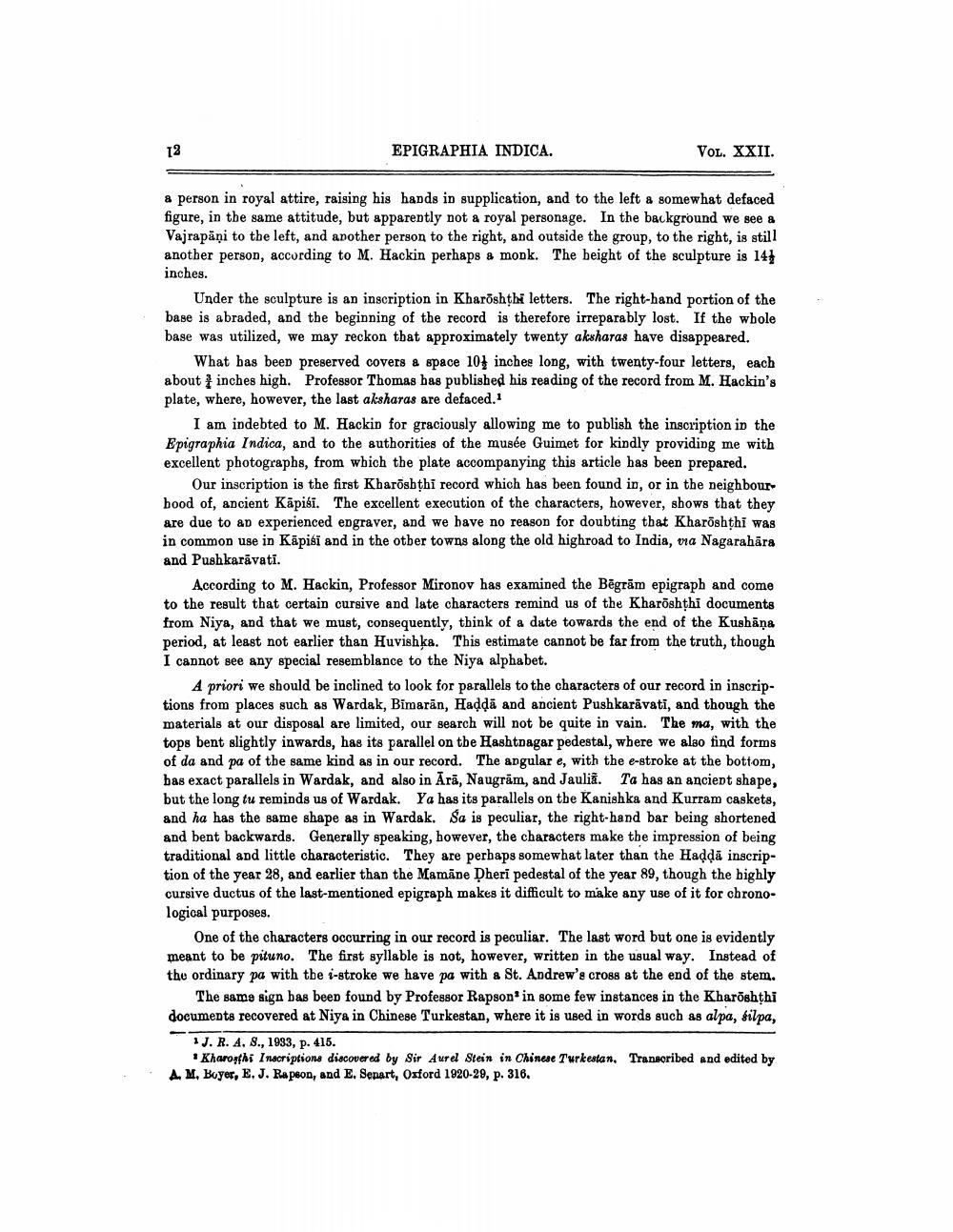________________
EPIGRAPHIA INDICA.
VOL. XXII.
a person in royal attire, raising his hands in supplication, and to the left a somewhat defaced figure, in the same attitude, but apparently not a royal personage. In the background we see a Vajrapäņi to the left, and another person to the right, and outside the group, to the right, is still another person, according to M. Hackin perhaps a monk. The beight of the sculpture is 141 inches.
Under the sculpture is an inscription in Kharoshthi letters. The right-hand portion of the base is abraded, and the beginning of the record is therefore irreparably lost. If the whole base was utilized, we may reckon that approximately twenty aksharas have disappeared.
What bas been preserved covers a space 104 inches long, with twenty-four letters, each about inches high. Professor Thomas bas published his reading of the record from M. Hackin's plate, where, however, the last aksharas are defaced.
I am indebted to M. Hackin for graciously allowing me to publish the inscription in the Epigraphia Indica, and to the authorities of the musée Guimet for kindly providing me with excellent photographs, from which the plate accompanying this article has been prepared.
Our inscription is the first Kharðsbthi record which has been found in, or in the neighbour bood of, ancient Kāpisi. The excellent execution of the characters, however, shows that they are due to an experienced engraver, and we have no reason for doubting that Kharoshthi was in common use in Kāpisi and in the otber towns along the old highroad to India, ma Nagarahāra and Pushkarāvati.
According to M. Hackin, Professor Mironov has examined the Bēgrām epigraph and come to the result that certain cursive and late characters remind us of the Kharoshthi documents from Niya, and that we must, consequently, think of a dute towards the end of the Kushāņa period, at least not earlier than Huvishka. This estimate cannot be far from the truth, though I cannot see any special resemblance to the Niya alphabet.
A priori we should be inclined to look for parallels to the characters of our record in inscriptions from places such as Wardak, Bimarān, Haddā and ancient Pushkarävati, and though the materials at our disposal are limited, our search will not be quite in vain. The ma, with the tops bent slightly inwards, has its parallel on the Hashtnagar pedestal, where we also find forms of da and pa of the same kind as in our record. The angular e, with the e-stroke at the bottom, bas exact parallels in Wardak, and also in Arā, Naugrām, and Jauliā. Ta has an ancient shape, but the long tu reminds us of Wardak. Ya has its parallels on the Kanishka and Kurram caskets, and ha has the same shape as in Wardak. Sa is peculiar, the right-hand bar being shortened and bent backwards. Generally speaking, however, the characters make the impression of being traditional and little characteristic. They are perbaps somewhat later than the Haddā inscription of the year 28, and earlier than the Mamāne Dheri pedestal of the year 89, though the highly cursive ductus of the last-mentioned epigraph makes it difficult to make any use of it for chronological purposes.
One of the characters occurring in our record is peculiar. The last word but one is evidently meant to be pituno. The first syllable is not, however, written in the usual way. Instead of the ordinary pa with the s-stroke we have pa with a St. Andrew's cross at the end of the stem.
The same sign bas been found by Professor Rapson' in some few instances in the Kharoshthi documents recovered at Niya in Chinese Turkestan, where it is used in words such as alpa, silpa,
1J. R. A, 8., 1933, p. 415.
* Kharoshi Inscriptions discovered by Sir Aurel Stein in Chinese T'urkestan, A. M. Buyer, E. J. Rapson, and E. Senart, Oxford 1920-29, p. 316.
Transcribed and edited by




